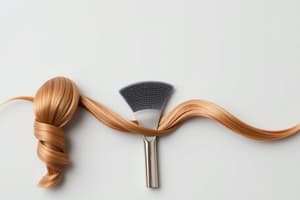Podcast
Questions and Answers
What are reference points and what is their function?
What are reference points and what is their function?
Reference points on the head mark where the surface of the head changes. They are used to establish design lines.
What are lines, sections, elevations, and guidelines?
What are lines, sections, elevations, and guidelines?
Lines are thin, continuous marks used as guides; sections are areas of hair separated prior to cutting; elevations are the degrees at which hair is held; guidelines are subsections that determine hair length.
What are important considerations to discuss with a client during a haircutting consultation?
What are important considerations to discuss with a client during a haircutting consultation?
It is important to discuss the client's lifestyle and hair type.
What is a razor, haircutting shear, styling or cutting comb, & texturizing shear used for?
What is a razor, haircutting shear, styling or cutting comb, & texturizing shear used for?
What are 3 things you can do to ensure good posture & body position while cutting hair?
What are 3 things you can do to ensure good posture & body position while cutting hair?
Name & describe the four basic types of haircuts.
Name & describe the four basic types of haircuts.
What is another name for bangs? When should you avoid cutting bangs? Name 5 basic types of bangs.
What is another name for bangs? When should you avoid cutting bangs? Name 5 basic types of bangs.
Name & describe 3 different texturizing techniques performed with shears.
Name & describe 3 different texturizing techniques performed with shears.
What is a clipper cut?
What is a clipper cut?
How is a trimmer used?
How is a trimmer used?
Flashcards are hidden until you start studying
Study Notes
Reference Points and Their Function
- Reference points mark changes in the hair's surface on the head.
- They help establish design lines for haircuts.
Lines, Sections, Elevations, and Guidelines
- Lines provide a thin, continuous mark for guidance during cutting.
- Sections are the areas into which hair is divided before cutting.
- Elevations refer to the degree that hair is lifted from the head while cutting.
- Guidelines are subsections that dictate the desired length for cutting.
Haircutting Consultation Considerations
- Discuss the client's lifestyle and hair type for tailored haircuts.
Tools Used in Haircutting
- A razor softens hair ends for a more blended look.
- Hair cutting shears create blunt or straight lines.
- A styling or cutting comb assists in most cutting procedures.
- Texturizing shears remove bulk and create texture in hair.
Good Posture and Body Position
- Position the client properly to ensure effective cutting.
- Center your weight for balance during haircutting.
- Work directly in front of the section being cut for precision.
Basic Types of Haircuts
- Blunt Haircut: Hair is cut straight across to form a weight line.
- Graduated Haircut: Results in buildup of weight through tension and low to medium elevation.
- Layered Haircut: Achieved by cutting hair at higher elevations, typically 90 degrees.
- Long Layered Haircut: Hair is cut at a 90-degree elevation, over-directed to maintain perimeter length.
Bangs
- Bangs are also known as fringe.
- Avoid cutting bangs on clients with cowlicks or low facial hairlines.
- Basic types of bangs include asymmetric, side-swept, versatile, short textured, and square bangs.
Texturizing Techniques with Shears
- Point Cutting: Performed using the tips of shears to create a textured edge.
- Notching: Similar to point cutting, creates texture by removing small amounts of hair.
- Freehand Notching: Also utilizes the tips of shears for more creativity in texturizing.
Clipper Cuts
- Clipper cuts use electric or battery-operated tools with two moving blades for efficient hair cutting.
Trimmer Usage
- Trimmers define edges around ears and necklines and can serve as a tattoo trainer for hard-to-reach areas due to their slender design.
Studying That Suits You
Use AI to generate personalized quizzes and flashcards to suit your learning preferences.




